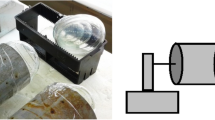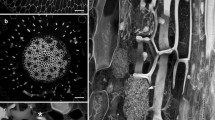Abstract
Root contraction in hyacinth (Hyacinthus orientalis L.) is marked by reoriented cell growth in the cortex of the contractile region. Cellular volume of the inner cortex enlarges fourfold during root contraction. This is associated with large increases in the radial and tangential dimensions and decreases in the longitudinal dimension of the cells. In order to determine the possible role of microtubules (MTs) in these changes we compared tubulin levels and MT numbers and orientation in contracted and non-contracted regions of hyacinth roots. Tubulin content was analysed by a radioimmunoassay; MT numbers and orientation were analyzed by counting profiles in sectioned material using transmission electron microscopy. Contracted tissue was found to have significantly higher levels of tubulin on a per-cell basis than non-contracted tissue, and also increased tubulin levels relative to total protein. The spatial MT frequencies were the same in contracted and non-contracted tissues, indicating a proportional increase in MT numbers in the expanded cells. Although the absolute spatial frequency of MTs was constant, the orientation, as determined by morphometric analysis of MT profiles, was not. While in the longitudinal section plane 42% of the MTs in the non-contracted cells were oblique, in the contracted cells the percentage of MTs presenting oblique profiles increased to 87%. Additionally, a qualitative difference in MTs was observed in contracted cells; electron-opaque material was seen peripherally associated with the MTs of the inner cortex. The changes in tubulin levels and in MT numbers as well as the qualitative differences in the MTs of contracted and non-contracted root regions indicate that, in hyacinth, reoriented cellular enlargement associated with root contraction cannot be explained simply by shifts in the arrangement of preexisting cortical MT arrays, but involves more complex changes in the cytoskeleton.
Similar content being viewed by others
Abbreviations
- MT(s):
-
microtubule(s)
- TEM:
-
transmission electron microscopy
- RIA:
-
radioimmunoassay
- Mr :
-
apparent molecular mass
References
Chen, S. (1969) The contractile roots ofNarcissus. Ann. Bot.33, 421–426
Cyr, R., Tocchi, L., Fosket, D.E. (1984) Immunological studies on plant tubulins isolated from diverse cell lines. (Abstr.) J. Cell Biol.99 (pt. 2), 41a
Cyr, R., Bustos, M., Guiltinan, M., Fosket, D.E. (1987) Developmental modulation of tubulin protein and mRNA levels during carrot (Daucus carota L.) somatic embryogenesis. Planta171, 365–376
Fukuda, H. (1987) A change in tubulin synthesis in the process of tracheary element differentiation and cell division of isolatedZinnia mesophyll cells. Plant Cell Physiol.28, 517–528
Green, P. (1962) Mechanism for plant cellular morphogenesis. Science138, 1404–1405
Halevy, A.H. (1986) The induction of contractile roots inGladiolus grandiflorus. Planta167, 94–100
Heath, I.B., Seagull, R.W. (1982) Oriented cellulose fibrils and the cytoskeleton: a critical comparison of models. In: The cytoskeleton in plant growth and development, pp. 163–182, Lloyd, C., ed. Academic Press, San Francisco
Hepler, P., Fosket, D. (1971) The role of microtubules in vessel member differentiation inColeus. Protoplasma72, 213–236
Jernstedt, J.A. (1984a) Seedling growth and root contraction in the soap plantChlorogalum pomeridianum (Liliaceae). Am. J. Bot.71, 69–75
Jernstedt, J.A. (1984b) Root contraction in hyacinth. I. Effects of IAA on differential cell expansion. Am. J. Bot.71, 1080–1089
Lang, J.M., Eisinger, W.R., Green, P.B. (1982) Effects of ethylene on the orientation of microtubules and cellulose microfibrils of pea epicotyl cells with polylamellate cell walls. Protoplasma110, 5–14
Lin, B.-L., Jernstedt, J.A. (1987) Microtubule organization in root cortical cells ofHyacinthus orientalis. Protoplasma141, 13–23
Mendenhall, W. (1971) Introduction to probability and statistics, 3rd edn. Wadsworth Publishing Co., Belmont, Cal., USA
Morejohn, L., Bureau, T., Fosket, D. (1985) Inhibition of plant cell proteolytic activities that degrade tubulin. Cell Biol. Int. Rep.9, 849–857
Morejohn, L.C., Fosket, D.E. (1982) Higher plant tubulin identified by self-assembly into microtubules in vitro. Nature297, 426–428
Olmsted, J.B. (1981) Tubulin pools in differentiating neuroblastoma cells. J. Cell Biol.89, 418–423
Ornduff, R. (1969) Ecology, morphology, and systematics ofJepsonia (Saxifragaceae). Brittonia21, 286–298
Palevitz, B., Hepler, P. (1976) Cellulose microfibril orientation and cell shaping in developing guard cells ofAllium: The role of microtubules and ion accumulation. Planta132, 71–93
Reynolds, E.S. (1963) The use of lead citrate at high pH as an electron opaque stain in electron microscopy. J. Cell Biol.17, 208–212
Roberts, I.N., Lloyd, C.W., Roberts, K. (1985) Ethylene-induced microtubule reorientations: mediation by helical arrays. Planta164, 439–447
Ruzin, S.E. (1979) Root contraction inFreesia (Iridaceae). Am. J. Bot.66, 522–531
Spurr, A.R. (1969) A low-viscosity epoxy resin embedding medium for electron microscopy. J. Ultrastruct. Res.26, 31–43
Stevenson, D.W. (1980) Observations on root and stem contraction in cycads (Cycadales) with special reference toZamia pumila L. Bot. J. Linn. Soc.81, 275–281
Vallee, R., Bloom, G. (1984) High molecular weight microtublue associated proteins (MAPs). Mod. Cell Biol.3, 21–75
Wilson, K., Honey, J.N. (1966) Root contraction inHyacinthus orientalis. Ann. Bot.30, 47–61
Author information
Authors and Affiliations
Additional information
I=Jernstedt (1984b)
Rights and permissions
About this article
Cite this article
Cyr, R.J., Lin, BL. & Jernstedt, J.A. Root contraction in hyacinth. II. Changes in tubulin levels, microtubule number and orientation associated with differential cell expansion. Planta 174, 446–452 (1988). https://doi.org/10.1007/BF00634472
Received:
Accepted:
Issue Date:
DOI: https://doi.org/10.1007/BF00634472




